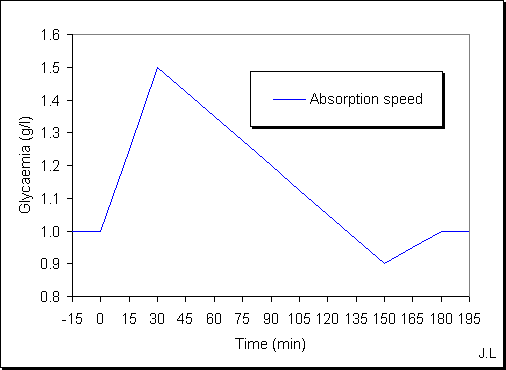
Characteristics of glucids
Depending on their chemical formula, glucids are named oligosaccharids (glucose, fructose, galactose), disaccharids (saccharose, lactose, maltose), polysaccharids (starch, glycogen).
Glycemia
Glycemia is the glucose concentration into blood. It is stabilized by two pancreatic hormones, insulin and glucagon. The insulin decreases the rate of glucose by favouring its use by cells and its stocking into glycogen or fats. At the opposite, the glucagon increases the rate of glucose.
Glycemia is normally about 1 g/l on an empty stomach, but this rate increases more or less depending on the type of ingested food.

N.B. The more the peak area is important, the more the food produces glucose.
The ratio between the peak of a food and the one of glucose, multiplied by 100, is named glycemic index. The glucose has therefore an index 100.
Foods classification
Foods can be classified according to their production of glucose in the blood. We distinguish the following concepts:
• The glucid content (%Glu) is the weight of glucid per 100g of food.
• The glycemic index (GI) represents the ability to produce glucose in the blood.
• The glycemic load (GL) represents la quantity de glucose produced in the blood: GL = %Glu . GI / 100.
Foods with high glycemic load must be privileged when the body needs to reconstitute the reserves of glycogen (training periods), otherwise these glucids are transformed into fats.
Fibers (celluloses, pectins, gums, etc.) improve digestion and limit the absoption of glucids (examples: whole bread, whole rice, whole pasta).